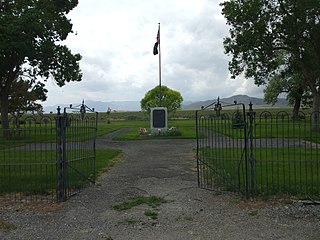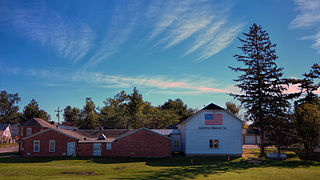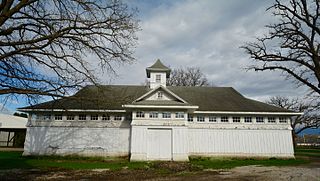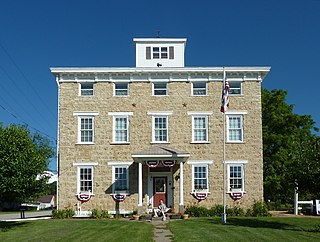
Ida County is a county located in the U.S. state of Iowa. As of the 2010 census, the population was 7,089. The county seat is Ida Grove. The county was authorized by the Iowa Legislature in January 1851 as a packet of projected counties in unorganized territory of western Iowa. It was named after Ida Smith, the first child of European immigrants to be born in this region.

Camp Floyd was a short-lived U.S. Army post in the Cedar Valley, Utah, United States. The Stagecoach Inn was a nearby hotel which also served as a stagecoach stop and, during 1860-1861, a Pony Express stop. Both were listed on the National Register of Historic Places in the 1970s, and now are included in a Utah state park known as Camp Floyd / Stagecoach Inn State Park and Museum.

The Stagecoach Inn in Newbury Park, California, originally known as the Grand Union Hotel, was used as a resting area for people who traveled from Los Angeles to Santa Barbara. Besides a hotel and stagecoach stop, it has also been used as a post office, church, restaurant and military school. It is California Historical Landmark no. 659 and is listed in the National Register of Historic Places. It played a major role in the development of the stage line transportation network in California. The hotel was also the first business venture in the Conejo Valley.

The First Coconut Grove Schoolhouse is a historic school located within City of Miami limits, in Dade County, Florida. The school originally resided at 2916 Grand Avenue, Miami, Florida, 33133. The structure was built in 1887, by Coconut Grove pioneer, Charles Peacock. Peacock reportedly constructed the house using wood gathered from ships wrecked in nearby Key Biscayne. The building originally served as a community gathering place, with Sunday School as its main purpose.

Built starting in 1852, the Stagecoach Inn of Salado, Texas, is thought to be the oldest extant structure in the village. The Inn was built as a stagecoach stop along the Chisholm Trail. The simple, two-story wood-frame building is in a frontier vernacular style. The structure was extended several times in the 1940s and 1950s to serve as a restaurant. The inn was listed on the National Register of Historic Places in 1983.

Fanthorp Inn State Historic Site is a historic hotel in Anderson, Texas. The Texas Parks and Wildlife Department acquired the 6-acre (2.4 ha) site by purchase in 1977 from a Fanthorp descendant. Ten years were spent researching and restoring the Inn to its 1850 look. The site was opened to the public on October 4, 1987.

Scotch Grove is an unincorporated community in Jones County, Iowa, United States. Scotch Grove is located on Iowa Highway 38, southeast of Monticello and north of Center Junction. The townsite was listed as a historic district on the National Register of Historic Places in 2014.

The Walker Tavern is a historic structure located at 11710 U.S. Route 12 in Cambridge Township in northwesternmost Lenawee County, Michigan. It was designated as a Michigan Historic Site on February 19, 1958 and was later the county's first property added to the National Register of Historic Places on January 25, 1971. The structure was incorporated into the Cambridge Junction Historic State Park and continues to serve as a museum and venue for various events.

The Ida County Courthouse, located in Ida Grove, Iowa, United States, was built in 1883. It was listed on the National Register of Historic Places in 1974 as a part of the County Courthouses in Iowa Thematic Resource. The courthouse is the second building the county has used for court functions and county administration.

The Muscatine County Fairgrounds are located in West Liberty, Iowa, United States. It hosts the annual Muscatine County Fair. The Muscatine County Historic Preservation Commission received a grant from the State of Iowa to study the fairgrounds in 2014. Most of it was listed as a historic district on the National Register of Historic Places as the West Liberty Fairgrounds Historic District in 2015. At the time of its nomination it consisted of 42 resources, which included 16 contributing buildings, two contributing sites, two contributing structures, 16 non-contributing buildings, and six non-contributing structures. Historic tax credits will be used to rehabilitate the historic buildings on the fairgrounds.

The Alvin Bushnell Bell House, also known as the Kee House, is a historic building located in Ida Grove, Iowa, United States. Alvin Bell was a native of Indiana and moved to Ida County in 1880. He was initially engaged in farming before he moved to Ida Grove where he was involved in a successful career in the livestock industry. By 1894, he had started to purchase land that would become the 1,200-acre (490 ha) Bell Ranch. The design of the house reflects one of the "mail order" houses of George Franklin Barber. It was constructed by local builders Thomas and William Bassett, and completed in 1895. The house is a 21/2-story frame house in the Queen Anne style. It is capped with a high hipped, cross gabled roof. The exterior features rich exterior ornamentation. Also on the property is one non-contributing structure. The house was listed on the National Register of Historic Places on January 27, 1983.

The Dr. Francis B. Warnock House is a historical building located in Battle Creek, Iowa, United States. Dr. Warnock was an Iowa native who received his degree from the University of Iowa in 1882. That same year he set up his practice in Battle Creek, and received his certificate from the State Board of Health in 1886. He bought the two lots the house sits on from his brother Samuel in 1883 and 1894. The design of the house reflects one of the mail order houses of George Franklin Barber. It was built by Ida Grove builders Thomas and William Bassett, and completed in 1899. The house is a 2½-story frame house that has a Sioux Falls red granite foundation. It is capped with a hip roof with three gabled sections. The Warnock house is an example of transitional residential architecture at the turn of the 20th-century that combines the Queen Anne and Colonial Revival styles. The Queen Anne influences include a round turret and a wraparound porch. The Colonial Revival elements include dentils, large Palladian windows, round porch columns, and Adamesque inspired ribbonwork. The house was listed on the National Register of Historic Places in 1988. It has been converted into a bed and breakfast known as the Inn at Battle Creek.

The Beers and St. John Company Coach Inn is a historic building located west of West Liberty, Iowa, United States. The company was granted the U.S. Mail delivery contract between Iowa City and Muscatine in 1839 and began service in 1841. Beers and St. John and Egbert T. Smith built this two-story frame structure the following year. At the time, Iowa was still a territory and Iowa City was the capital. It was a swing station where horses and drivers were switched, and it was a crossroads where the Muscatine-Iowa City route crossed with the Davenport-Iowa City route. Smith's wife died in 1854 and is buried on the property, as is a family who died while staying here. The inn closed in 1855 with the arrival of the railroad, and the building was converted into a house.

Walnut Grove School is a historic one-room schoolhouse located southwest of Osage in rural Mitchell County, Iowa, United States. It was in operation from 1857 to 1946, and it educated anywhere from five to thirty-three student at a time. The frame structure built on a limestone foundation was constructed in 1873 on the same site as the building it replaced. A bell tower with a cast iron bell is located on the gable roof above the main entrance. Its property is on the edge of a timber along Rock Creek. In 1911 there were 88 one-room school houses in Mitchell County. This is the only one that is unaltered and in its original location. The area was settled by Norwegian pioneers in 1853. They named their small town Meroa, which has been reduced to his old schoolhouse, a Lutheran church, a cemetery, and a few houses. The building was listed on the National Register of Historic Places in 2002.

Coffin's Grove Stagecoach House, also known as the Henry Baker House, was a historic building located west of Manchester, Iowa, United States. Coffin's Grove was named for Clement Coffin who settled in the area in 1840. His son-in-law Henry Baker joined him the following year. The house was built in 1855 to accommodate the increase in travelers passing through the area. It served as a hotel, post office and the second floor was used for community functions like dances. The two-story Colonial style was unusual for a structure this far west. It is typically found in Ohio. The house featured a foundation of limestone quarried on the property and brick that was kilned here. Across the road from where the house was located are the remnants of barns built in 1849. They were the first frame barns in the Delaware County. The house was listed on the National Register of Historic Places in 1975.

The Nathaniel Butterworth House is a historic residence located north of Andrew, Iowa, United States. It is one of over 217 limestone structures in Jackson County from the mid-19th century, of which 101 are houses. The Butterworth house features a five bay symmetrical facade capped by a gable roof. The stones, which were said to have been quarried on this farm, are of various sizes and shapes and are laid in courses. Unlike many of the stone houses in Jackson County, the Butterworth house makes use of Classical entablature and pilasters around the transom and the sidelights of the main entry. The double end chimneys are found on only two other stone houses in the county.

The Sherrill Mount House, also known as the Fries Hotel, Moundside Apartments, and The Inn at Sherrill, is a historic building located in Sherrill, Iowa, United States. This is one of the few surviving pre-Civil War hotels left in Iowa, and one of the largest early stone structures remaining in rural Dubuque County. The three-story building is composed of native limestone with a cupola on top of the hip roof. It was built along a stagecoach route that traveled along the Mississippi River. At one time it was situated on a 40-acre (16 ha) plot of land on which were several out buildings for an agricultural operation that included an orchard and vineyard. The building also served the community as a post office and meeting hall. Before national prohibition in 1919 the inn included a beer garden, tavern and dance hall. It was at this time that the building was converted into an apartment building. It has subsequently been converted into a bed and breakfast called the Black Horse Inn. The house was listed on the National Register of Historic Places in 2002.

Four Mounds Estate Historic District is a nationally recognized historic district located in Dubuque, Iowa, United States. It was listed on the National Register of Historic Places in 2002. At the time of its nomination the district consisted of 19 resources, including 11 contributing buildings, two contributing sites, four non-contributing structures, and two non-contributing buildings. The estate is named for the four conical burial mounds that are located on the property. They are one of the historic sites, and they are individually listed on the National Register of Historic Places.

The Pucker Street Historic District is a nationally recognized historic district located in Marion, Iowa, United States. It was listed on the National Register of Historic Places in 2002. At the time of its nomination it consisted of 84 resources, which included 50 contributing buildings, three contributing structures, two contributing objects, and 29 non-contributing buildings. The historic district is a residential area near Marion's central business district. The people who initially built homes here were the city's pioneer families and then their descendants. It is also where the city's wealthy and influential citizens built their houses along Eighth Avenue and its adjacent streets. The neighborhood was called "Pucker Street" because of the superior attitudes that some of its early residents were said to have possessed.

The Daniel Dayton House, also known as Ravine House, is a historic stagecoach inn in Harmony Township, Minnesota, United States. It was built in 1857 as an overnight stop on the Dubuque–St. Paul Stage Road, a frontier mail and stagecoach route through Iowa and Minnesota. The house was listed on the National Register of Historic Places in 1977 for its local significance in the themes of architecture, exploration/settlement, and transportation. It was nominated for being one of Minnesota's few surviving stagecoach inns, for its stone architecture, and for its association with the pioneer era of Harmony Township.





















